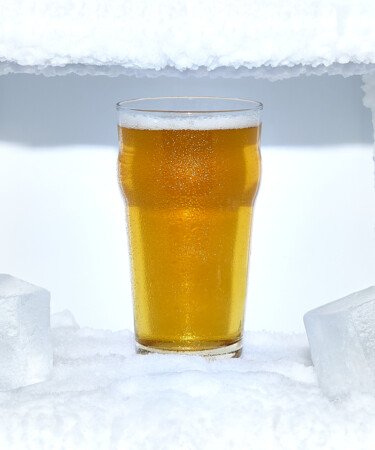A frosted glass is pure eye candy. Nothing in the beer world is quite as photogenic as an icy, frothed-up mug with foam spilling over the side. But the next time you spot footage from Oktoberfest with festival goers in lederhosen and dirndls clinking mugs of Märzen, take a closer look and you’ll see that these glasses bear no such frost. A mistake? Not so much. In fact, there’s only one type of brew that’s ready-made for a beer glass pulled straight from the freezer.
Frosted beer mugs may look great, but it turns out they actually do a number on the drinking experience. They can ruin a beer’s carbonation, dull its flavor, and even impart strange tastes from other products that share freezer space with said mug. That’s why when you’re serving most brews, you’ll want to stick to clean, room-temp or lightly chilled glassware. This will optimize two of the most important factors when it comes to making beer as tasty as possible: temperature and foam.
The ideal serving temp for beer is between 38 and 55 degrees fahrenheit, and the closer beer is to freezing temps, the more CO2 it retains — that means more foaming up occurs in the drinker’s belly, resulting in bloating. When ice crystals form inside a frosted glass, they act as a primer for CO2 expansion. In that case, the beer itself will foam up wildly from the get-go. This looks cool, no doubt, but it will cause the beer to go flat a lot faster. And if you’re pumping that beer from a properly refrigerated keg, you don’t have to worry about chilling your glass at all.
Your glass similarly affects your beer’s foam. Depending on the style, roughly half an ounce of foam (a .5-inch to a 1.5-inch inch head) is the industry ideal. The amount of foam a beer produces can depend on a number of factors, from the beer’s ABV to the angle at which it’s poured into the glass. Hell, even the oils in lip balm can hinder a proper level of foam. And the higher a beer’s ABV is, the less foam it tends to produce, as it takes less time for the brew’s alcohol to eat the foam. Protein, yeast, and hop residue are all contained within a beer’s head, and an even-keeled head is a good indicator of a healthy level of carbonation. Plus, carbonation helps to release the flavor and aroma of beer over time. If you serve beer in a glass pulled straight from the freezer, you disrupt the carbonation, and therefore disrupt the flavor. And while that glass is in the freezer, it’ll likely pick up smells from other products inside as air circulates throughout the appliance.
Still, as we said, there are exceptions to the frosty glass rule. If your goal is to down a beer as quickly as possible, a frosted mug is the drinking vessel to reach for. And what better style of beer to drink when time is of the essence than a good ol’ macro lager? We’re talking Budweiser, Miller, PBR, Coors — all the party-time brews that people generally love more for their nostalgia and drinkability than their actual taste. It may sound crass, but the colder they are, the easier they are to put down, end of story. These brews will certainly foam up to high heaven and lose some carbonation in the process, but if you’re craving something ice-cold and refreshing, it doesn’t get much better than a frosted glass of PBR.
Beer enthusiasts will argue to the ends of the Earth that absolutely no beer of any kind deserves to be punished by frosted glassware — and rightfully so, and it generally does more harm than good. Still, there’s a specific kind of euphoria that comes from enjoying your choice macro lager in a mug pulled straight from the tundra of your Frigidaire. As long as you don’t mind some dulled aromatics and a hint of freezer funk, pour up.
